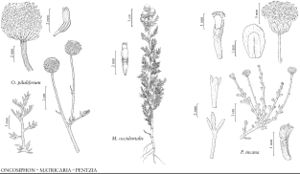Matricaria
Sp. Pl. 2: 890. 1753.
Gen. Pl. ed. 5, 380. 1754.
| Taxon | Illustrator ⠉ | |
|---|---|---|
 | Oncosiphon piluliferum Matricaria occidentalis Pentzia incana | John Myers Yevonn Wilson-Ramsey John Myers |
Annuals, (1–) 10–25 (–80) cm (taprooted; often aromatic). Stems 1–10+, usually erect or ascending, sometimes decumbent, branched or not, glabrous or glabrate to sparsely hairy (hairs basifixed). Leaves (not marcescent) basal (soon withering) and cauline; alternate; subpetiolate or sessile; blades spatulate to oblong or ovate (bases sheathing or clasping, often pinnately auriculate), (1–) 2–3-pinnately lobed (lobes linear, often curved distally), ultimate margins entire (± recurved), mucronate, faces glabrous or glabrate to sparsely hairy (hairs basifixed). Heads radiate or discoid, borne singly or in open, corymbiform arrays. Involucres patelliform, 4–14 mm diam. Phyllaries persistent, 25–50 in [2–] 3–4 [–5] series, distinct, oblong or ovate to spatulate or linear-spatulate (membranous, not carinate, bases not indurate), subequal, margins and apices (hyaline) scarious (apices rounded to obtuse). Receptacles conic to oblong-ovoid [subulate] (hollow), epaleate. Ray-florets 0 or 10–22, pistillate, fertile; corollas white, laminae elliptic-ovate. Disc-florets 120–750+, bisexual, fertile; corollas (persisting in fruit, often slightly asymmetric, sometimes with scattered, sessile, golden glands) yellow to greenish yellow or yellowish green, tubes (± dilated), throats urceolate to campanulate, lobes 4–5 (spreading), deltate [with resin sacs]. Cypselae obconic, slightly compressed (usually asymmetric, apices oblique), ribs [3–] 5, faces glabrous, smooth between ribs (pericarps sometimes with myxogenic cells abaxially and/or in ribs; embryo-sac development monosporic); pappi 0, coroniform, or (sometimes on ray cypselae) adaxial auricles. x = 9.
Distribution
North America, Eurasia, North Africa, some species widespread weeds in the southern hemisphere
Discussion
Species 7 (3 in the flora).
Matricaria has been confused with Tripleurospermum (see discussion under the latter). Typification of Matricaria was discussed by K. Bremer and C. J. Humphries (1993), who rejected the arguments of S. Rauschert (1974) in favor of the use of Chamomilla over Matricaria.
Selected References
None.
Key
| 1 | Heads radiate (ray corollas white); disc corollas yellow to greenish yellow, lobes 5; cypselae 0.75–0.9 mm; pappi usually 0, sometimes coroniform (entire or lobed) or (on ray cypselae) each a toothed auricle | Matricaria chamomilla |
| 1 | Heads discoid; disc corollas greenish yellow, lobes 4(–5); cypselae 1–1.5 mm (ribs, at least 2 lateral, each with longitudinal mucilage gland); pappi coroniform, entire or lobed | > 2 |
| 2 | Heads (1–)4–50(–300); discs 4–7(–11) × 4–7.5(–10) mm; cypselae: 2 lateral ribs each with mucilage gland along ± entire length; pappi coroniform, entire; plants aromatic (pineapple odor when bruised); stems 1–10+, usually erect or ascending, sometimes decumbent, branched from bases | Matricaria discoidea |
| 2 | Heads 1–15+; discs 5–12.5 × 6–14 mm; cypselae: 2 lateral ribs each with mucilage gland in distal 1/2 (glands expanding into lobes); pappi coroniform, lobed (lobes 2, abaxio-lateral); plants not notably aromatic; stems usually erect, sometimes ascending, simple or branched mostly distally, sometimes proximally (then ascending) | Matricaria occidentalis |